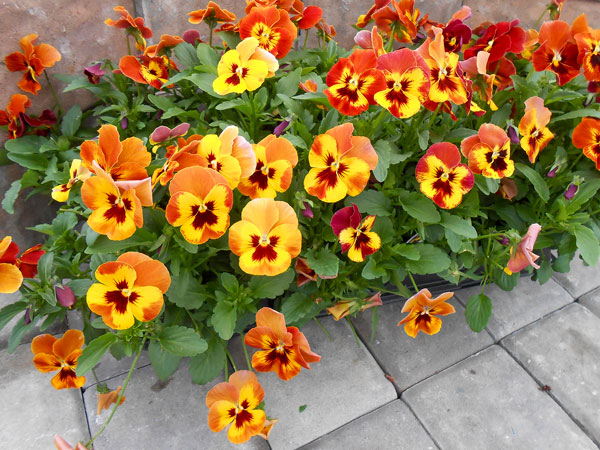3/1/2023
The Pansy Toolboxes
Lowell Halvorson

Pansy brands are best understood as toolboxes, like sets of sockets or wrenches. All the major suppliers define their brands according to behavior they admire: compact or vigorous, trailing or upright, and so forth. It’s no different than Stanley organizing their sockets by metric, standard and Torx. Granted, the brands overlap in many areas, but they also have their differences, shaped by the collision of highly global breeding and highly local growing.
Breeding globally
First and foremost, pansy series are wholesale brands, focused on the golden one (the seed buyer) and the one immediately downstream (the plug buyer). Spillover happens beyond this point, but money and labor focus on these two players.
Pictured: Delta Classic Fire Pansy from Syngenta. This month, Syngenta announced that the company is reorganizing the Delta series into 16 “Pros” and 10 “Classics” (not including mixes).
Second, breeding pansies is a global affair where four firms dominate: Syngenta, PanAmerican Seed, Sakata and Benary. To be credible, each company ships world-class seed. Anything less gets squeezed out of the markets.
Third, seed ships everywhere—north, south, east and west—in the spring and the fall. The scope is wide because high volumes are needed to pay for these programs. Chunks of continents usually define the market focus, like Southeastern United States, Japan or Northern Europe.
Breeders assemble series like sets of sockets and wrenches with specialty lines to supplement them. Swap “long day/short day” for metric/standard or “heat tolerance” for drive size. It works the same way.
Growing locally
The trick is the rummaging. Growing pansies is local, not global. Unlike begonias or vinca, who happily march to their genetic code, pansies consider their genetics more as a serving suggestion. Pansies are highly influenced by their environment. Look up—your location determines the length of the day. Seasons make days grow longer or shorter. The weather influences light quality.
Pansies also respond to small variations in temperature, soil and water, as well as breezes, kisses, hugs and the fluff of the teddy bear left overnight to comfort them. So, so many details whisper, wink and nod their influence on the crop.
Growers sit on top of all those differences. Whether you lay down your pansies by the house or the acre, each location spins a slight twist on the adventure called crop performance.
The toolbox metaphor helps here. Pansy series are genetic tools gathered around a common set of behaviors, so a pansy grower can reach in and grab that one socket that bites onto the bolt and turns it right away. It helps to know the strengths of the sets. Ingenuity pops open two flowers quickly. Majestic is respected for its extra-large flowers. Matrix optimizes for spring (short to long days) and fall (long to short days). This brings us to Delta.
Changing the Delta toolbox
This month, Syngenta announced the re-organization of their Delta line. Delta Pro replaces Delta Premium, but it’s not a one-for-one swap. Instead, Syngenta put their colors onto a table and filled two buckets: 16 “Pros” and 10 “Classics” (I don’t count mixes). Colors belong to one or the other, but not both. Moving forward, Classic colors will upgrade into Pro status based on three merits.
The big one is timing, defined as a 10-day window between Clear Yellow (the earliest) and Blue Blotch (the latest). Every other Pro color blooms in between these two. Most Pro varieties show their colors by the eight-day mark.
Next is a consistent habit. As the pansies fill out in the Syngenta style, survey the crop. Delta Pro wants as few exceptions as possible. Just for the record, pansies always have exceptions. For example, scattered among the crop, a certain number of plants might get stretchy at a certain light level. Delta Pro aims to minimize that. A consistent height to the deck is good.
Or sometimes, a few pots go blind because they need a little more light than the surrounding plants in order to bloom. Delta Pro gets on top of that. Detail after detail, Delta Pro strives for less wobble and more uniform results in the style of other annual crops.
The third merit is chemistry. The nice habit appears with a lower PGR. The crop moves as a team, not as a mob, so this consistency rewards other chemistries. Altogether, it improves the grower’s accuracy to ship what they want, when they want.
Feeling the pain
In the end, are these changes relevant? Well, if you feel the pain, then yes. If you schedule different plantings for different colors so they ship at the same time, Delta Pro feels for you. If a consolidated regime with consistent results gives you less grief, Delta Pro can help. If you think less PGRs sounds good on the budget, Delta Pro wants to speak with you.
I talk about Delta because Syngenta re-organized their pansies this month with a better focus, but Matrix, Majestic and Ingenuity work as toolboxes just as well. Their series break down into solutions and each one pushes against problems differently. Gathered all together, the full tool chest is well appointed.
Errata
In a previous column on impatiens, I mentioned that hybrids mixed I. hawkeri with I. walleriana. I was wrong on this point. A variety of species are used (and no one wants to talk about their secret recipes), but I. walleriana isn’t one of the ingredients found in the hybrids SunPatiens, Bounce, Solarscape or Sun Harmony. GT
Lowell Halvorson is a consultant and writer in Fairfield, Connecticut, for retail and wholesale horticulture, specializing in business development. He also covers the breeding community for GrowerTalks magazine. You can contact him at (203) 257-9345 or halvorson@triadicon.com.